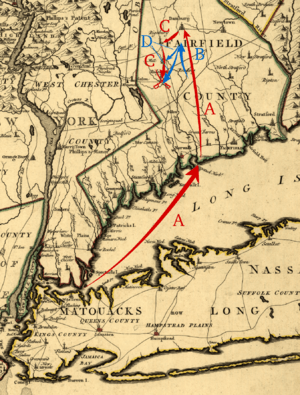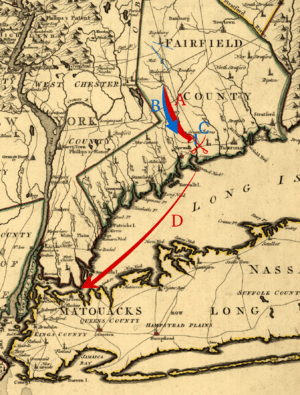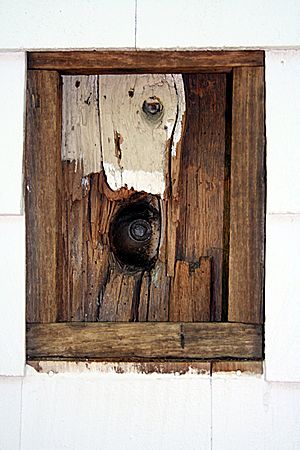Battle of Ridgefield facts for kids
Quick facts for kids Battle of Ridgefield |
|||||||
|---|---|---|---|---|---|---|---|
| Part of the American Revolutionary War | |||||||
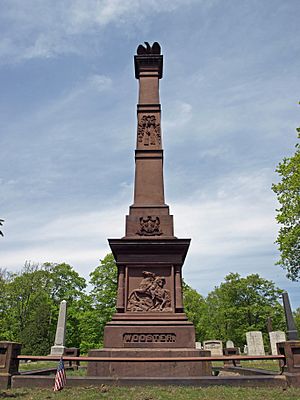 Monument to David Wooster in Danbury, Connecticut |
|||||||
|
|||||||
| Belligerents | |||||||
| Commanders and leaders | |||||||
| David Wooster † Gold S. Silliman Benedict Arnold John Lamb Jedediah Huntington Henry Ludington Joseph Platt Cooke |
William Tryon William Erskine James Agnew Henry Duncan |
||||||
| Strength | |||||||
| 700 (Ridgefield) 1,000 (landing skirmish) |
1,800 6 guns |
||||||
| Casualties and losses | |||||||
| 20 killed 40–80 wounded |
104–154 killed and wounded 40 captured |
||||||
The Battle of Ridgefield was an important fight during the American Revolutionary War. It involved American and British soldiers. The main battle happened in Ridgefield, Connecticut, on April 27, 1777. More small fights took place the next day near the coast of Westport, Connecticut.
On April 25, 1777, British troops landed near Westport, Connecticut. They were led by Major General William Tryon, the Royal Governor of New York. They marched to Danbury, Connecticut, where they destroyed many Continental Army supplies. A small group of American soldiers tried to stop them but were chased away.
News of the British attack spread quickly. Connecticut militia leaders got ready to fight. Major General David Wooster, Brigadier General Gold Selleck Silliman, and Brigadier General Benedict Arnold gathered about 700 American soldiers and local militia. They tried to stop the British from destroying supplies in Danbury, but they were too late. Instead, they decided to attack the British as they returned to the coast.
General Wooster's group attacked Tryon's rear guard twice on April 27. Wooster was badly wounded in the second attack and died five days later. The main battle then happened in Ridgefield. Several hundred militia led by Arnold fought the British. The Americans were pushed back through the town's main street. But they still managed to hurt many British soldiers. More militia arrived, and they kept bothering the British the next day. The British were trying to get back to Compo Point in Westport, where their ships were waiting. Arnold gathered the militia and some cannons to make a final stand. But the British surrounded his position and scattered his forces with cannon fire and a bayonet charge.
The British won the battle, but their raid made many people in Connecticut support the American cause even more.
Contents
Why the Battle Happened: Background
Connecticut had been mostly peaceful during the first two years of the American Revolutionary War. But in 1777, British General William Howe planned to capture Philadelphia, the American capital. He also allowed General William Tryon to attack places in Connecticut. Tryon was given a mission to raid a Continental Army supply base in Danbury, Connecticut. Howe had learned about this supply base from a spy.
A group of 12 transport ships and other smaller boats was put together. They were led by Captain Henry Duncan. The landing force had 1,500 regular British soldiers. It also included 300 Loyalist soldiers and a small group of cavalry. Generals Sir William Erskine and James Agnew helped lead these troops. General Tryon was in charge of the whole operation. The ships left New York on April 22, 1777.
The Danbury supply base was created in 1776. It mostly helped American forces in the Hudson River valley. In April 1777, there were about 50 Continental Army soldiers and 100 local militia there. They were led by Colonel Joseph Platt Cooke.
The Attack on Danbury
On April 25, the British ships arrived at the mouth of the Saugatuck River. Tryon's troops landed at Compo Point in Westport, Connecticut. They marched inland about 8 miles (13 km) and camped in Weston. They reached Danbury early the next afternoon. Along the way, American militia fired at them, trying to slow them down.
The British drove off Colonel Cooke's troops. They killed at least three Americans and captured two others. Before leaving the next morning, the British destroyed huge amounts of supplies. This included 4,000 to 5,000 barrels of food, 5,000 pairs of shoes, and 1,600 tents. They also drank a lot of rum. Houses belonging to Loyalists (people who supported the British) were marked so they would not be burned.
When the British ships were first seen, American messengers quickly warned Danbury and local militia leaders. Major General David Wooster and Brigadier General Benedict Arnold were in New Haven. They heard the news on April 26. Wooster immediately sent local militia to Fairfield. When he and Arnold reached Fairfield, they learned that General Silliman had already gone to Redding. Silliman was gathering about 500 militia and 100 regular soldiers. The alarm spread as far as Peekskill, New York. American troops there also started to get ready.
The American forces marched toward Danbury in heavy rain. By 11 pm, they were only about 2 miles (3.2 km) from Danbury. Their gunpowder was wet, so they could not fight. They spent the night in Bethel, Connecticut.
Fighting in Ridgefield
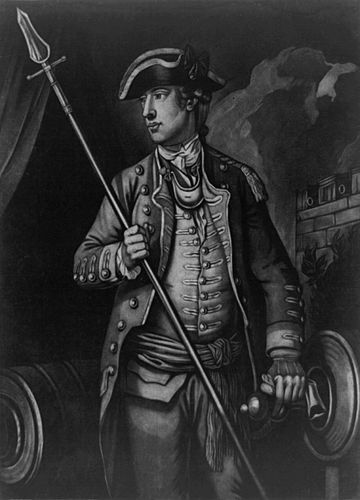
General Tryon learned about the Americans in Bethel around 1 am on April 27. This made him decide to leave Danbury sooner. He ordered the homes of Patriots (Americans who supported independence) to be burned. More than twenty buildings were destroyed. The British troops left Danbury around dawn. They marched south toward Ridgefield to try and avoid General Wooster's forces.
General Wooster wanted to slow Tryon down until more American soldiers arrived. He split his forces. About 400 men went with Generals Arnold and Silliman to Ridgefield. There, they met another 100 militiamen and built simple barricades on the road through town. General Wooster personally chased the British column with his remaining 200 men. Local Patriots helped him by destroying at least one bridge.
Wooster attacked Tryon's rear guard as they stopped for breakfast. This was about 3 miles (4.8 km) north of Ridgefield. He killed at least two British soldiers and took about forty prisoners. He then retreated into the nearby woods. An hour later, he attacked again. But the British were more prepared. They had three cannons with their rear guard, firing grapeshot at the Americans. General Wooster, who was 67 years old, rallied his men. Moments later, he was badly wounded. He died five days later in Danbury. Wooster's attacks gave Arnold and Silliman enough time to set up defenses in Ridgefield.
The British arrived at Arnold's barricade in Ridgefield sometime after noon. After an hour of cannon fire, Tryon sent groups to attack both sides of the American position. General Silliman had expected this and placed soldiers there to stop the first attacks. The British outnumbered the Americans by more than three to one. Tryon decided to attack on all three fronts. General Erskine led 600 men with cannon support against the barricade itself. General Agnew sent soldiers to attack from the sides, which helped break through the barricade.
The British then chased the American forces down Town Street. They took control of the town. The Americans had 12 dead and 24 wounded. They retreated under General Arnold's orders. After the barricade was broken, Arnold was between his men and the enemy. His horse was hit by nine musket shots and fell, pinning him. A British soldier charged, telling Arnold to surrender. Arnold shouted "Not Yet!" and shot the soldier, killing him. He then ran off with his troops, with a slightly injured leg. This whole fight took about fifteen minutes.
British Return to Their Ships
The British forces camped just south of Ridgefield for the night. They left the next morning, burning six houses and the Episcopal church. The church was used as an American supply depot and hospital. During the night, the American militia regrouped. Colonel Jedediah Huntington now led them. More militia from Connecticut and Dutchess County, New York joined them. This made the force about 500 men.
This larger American force constantly attacked the British as they marched south. It was similar to the British retreat from Concord at the start of the war. From behind stone walls, trees, and buildings, the militia kept firing at the British.
Meanwhile, General Arnold had gathered about 500 more American soldiers further south. This included a small group of artillery led by Colonel John Lamb. Arnold took a strong position on Compo Hill. This spot overlooked the roads leading to the beach. He waited for the British to arrive. But Tryon's forces crossed the Saugatuck River well above Arnold's position. This made Arnold and the chasing militia try to trap the British before they reached the beach.
However, the British column moved very fast. They reached high ground and were joined by fresh marines from their ships. These marines helped cover the British as they got onto their boats. Arnold prepared his force to attack. But a well-timed bayonet charge by Erskine's men broke the American formation. Colonel Lamb was injured, and Arnold had a second horse shot out from under him. The British successfully got onto their ships and sailed back to New York.
The British officially reported 26 killed, 117 wounded, and 29 missing. American reports said the British had 40 prisoners taken.
The Americans were reported to lose about 20 killed. Between 40 and 80 were wounded. The British claimed more than 100 Americans were killed and over 250 wounded. They also wrongly reported that Colonel Lamb was killed. His injuries were so bad that he looked dead on the field.
What Happened After: The Aftermath
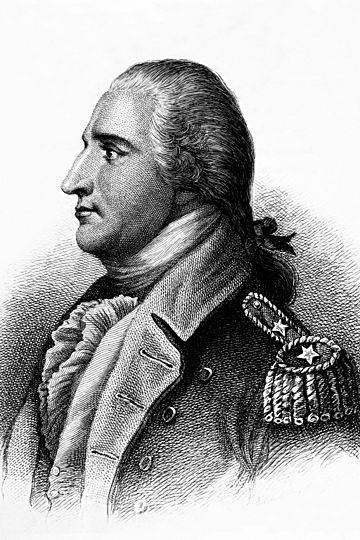
Even though the British won the battle, their raid on Danbury and actions in Ridgefield had a big effect. The strong resistance from the Americans made more people join the American military in the area. This stopped the British from trying to land troops by ship to attack inland American strongholds again. The British also never again tried to fight inland in Connecticut.
The British destroyed at least 19 houses and 22 stores and barns. They also ruined many military and medical supplies. The town of Ridgefield estimated the damage was over £16,000. They asked Congress for money to help. Congress sent £500 to the town leaders. Later, in 1787, the state gave them land in the Ohio Country. This land now includes Sandusky, Ohio.
The raid made more people in the area support the Patriot cause. Soon after Tryon left Compo Beach, about 3,000 Connecticut citizens joined the Connecticut Army of Reserve. In May, Lieutenant Colonel Return Jonathan Meigs led a revenge raid. He attacked a British position in Sag Harbor, New York. Connecticut later sent soldiers to help General Horatio Gates defeat Lieutenant General John Burgoyne at the important Battles of Saratoga in 1777. They also sent militia to help defend the Hudson River at Peekskill.
Tryon attacked Connecticut again in 1779, but only raided port towns. The last big British raid was led by Benedict Arnold after he switched sides. His 1781 raid on New London included a tough fight by the militia at Groton Heights.
Benedict Arnold was rewarded for his part in the Ridgefield fight. He had planned to go to Philadelphia to complain to the Second Continental Congress. Other officers, who were less experienced than him, had been promoted to major general before him. But because of his brave actions at Ridgefield, he was promoted to major general. He was also given a horse as a reward for his "gallant conduct." His seniority over the other officers was later restored after his important help at Saratoga.
Sybil Ludington's Ride
Sybil Ludington was a 16-year-old girl. She was the daughter of Colonel Henry Ludington, a militia leader from Dutchess County. She is famous for her night-long ride to warn American troops about the Danbury raid. However, modern historians say there is not much proof for this story. It first appeared in a short mention in her grandfather's memoirs, published in 1907. So, whether the ride actually happened is still debated.
Family stories say a tired messenger arrived at the Ludington house. He told them about the British moving toward Danbury. Sybil then rode through nearby towns, mostly in today's Putnam County. She woke up the local militia. In her family's account, she rode more than 40 miles (64 km) through a rainy night. She warned Patriots and avoided Loyalists to gather the troops. Ludington's men arrived too late to help at Ridgefield. But they were part of the force that bothered the British as they returned to the beach.
Remembering the Battle: Legacy
Since 1877, people in Ridgefield have remembered the battle every 25 years with a special ceremony. In 1908, Connecticut Governor Phineas C. Lounsbury hosted a big event at his mansion. This was part of the town's 200th birthday celebration. For the 150th anniversary in 1927, a book called History of Ridgefield was published. The 200th anniversary was held a year early in 1976 to match America's bicentennial celebration. Both the 200th and 225th anniversary events included re-enactments of the battle. For these, parts of Town Street (now Main Street) were covered with dirt to make it look more real.
In 1854, a monument was built in Ridgefield to honor David Wooster. The Keeler Tavern is now a local museum. It still has a British cannonball stuck in the side of the building. Signs are placed at important spots around town. These include where David Wooster was badly wounded and where Benedict Arnold was pinned under his shot horse. There is also a stone marker near the barricade where both American and British soldiers were buried together. In New Haven, a public square and a street were named for Wooster.


